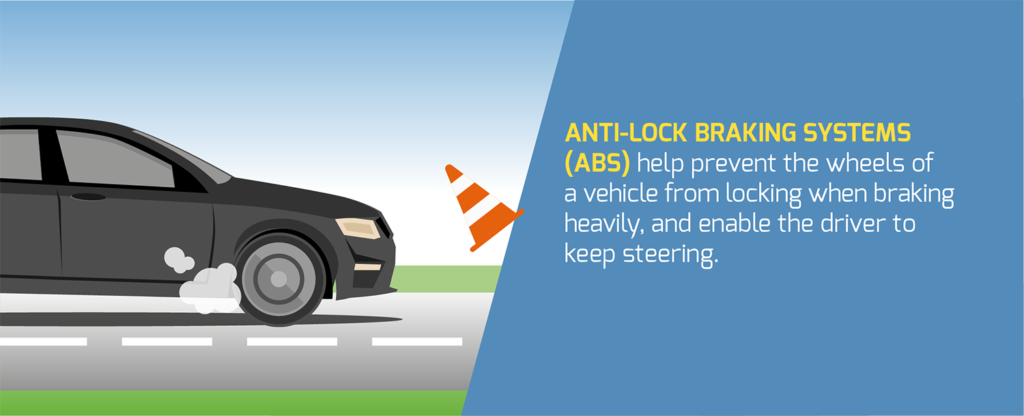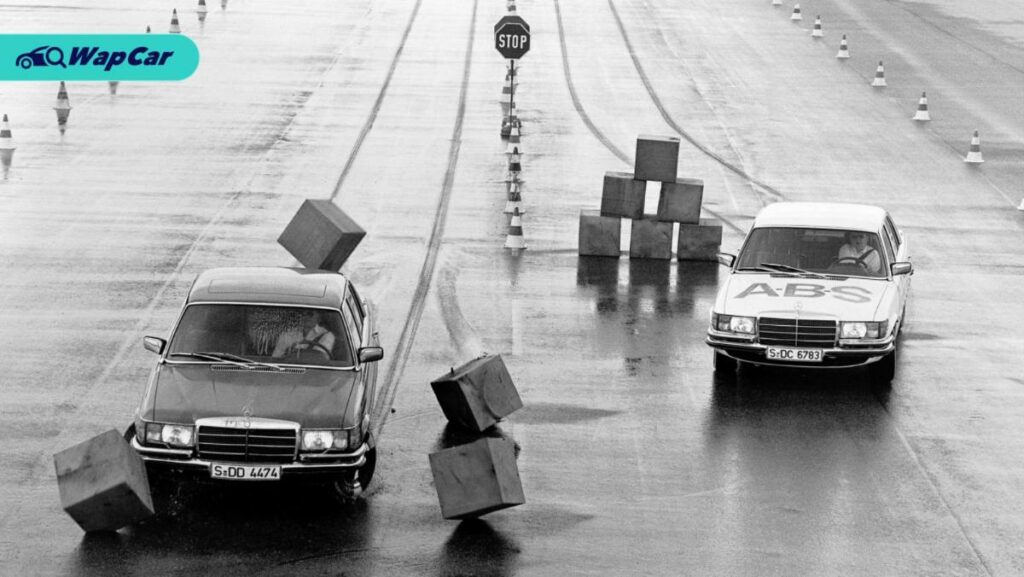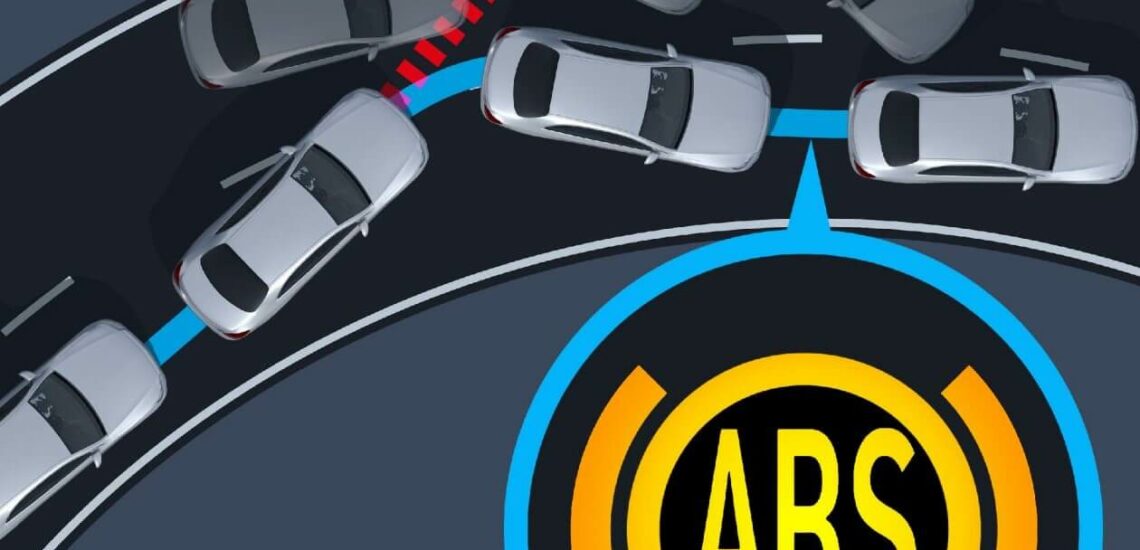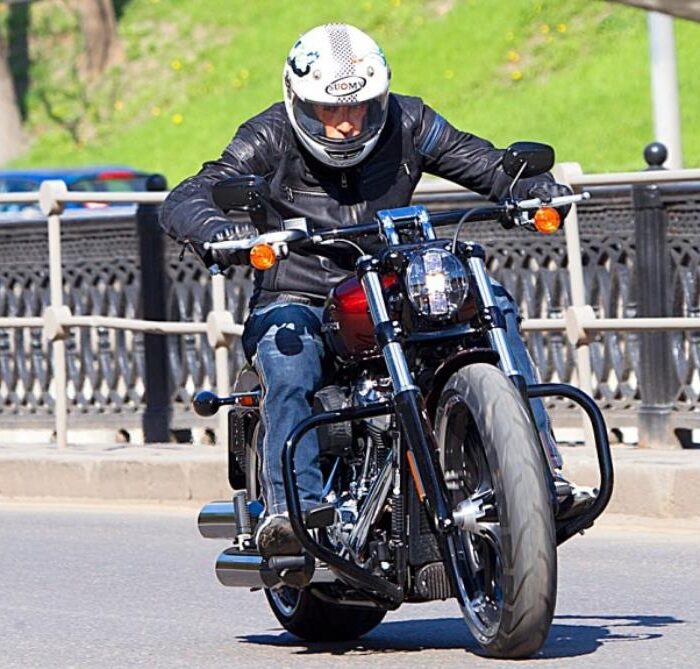Você já teve que contornar um obstáculo repentino e frear ao mesmo tempo? Provavelmente sim. Parece que isso não é difícil – aplique um freio, gire o volante e corrija uma trajetória. No entanto, tudo é relativamente simples até certo ponto. Se você pressionar o pedal do freio com mais força do que o necessário durante a frenagem de emergência, as rodas podem travar e…
Então, há dois cenários possíveis. Ambos se devem à presença ou ausência de um sistema antibloqueio de frenagem (ABS). Se um carro é arcaico e tem sua genealogia de meados dos anos 70, não importa o quanto você gire o volante, o veículo não mudará a trajetória. O fato é que rodas trancadas, derrapando, privam o motorista da oportunidade de manobrar – quando o carro anda de peixe, ele simplesmente dirige em linha reta, como se o volante estivesse cortado. Somente um motorista experiente será capaz de destravar as rodas com frieza soltando o pedal do freio por um momento. E então, usando a frenagem por impulso, retorne o controle e reduza a velocidade. A segunda opção é para um carro equipado com ABS. O motorista só precisa pressionar o pedal do freio com mais força e trabalhar com o volante com calma. Você sente a diferença?
O bloqueio também é perigoso porque pode fazer com que o carro derrape ou se mova para o lado. Isso pode acontecer quando há um pavimento diverso sob as rodas, a carga nos eixos é bastante alterada durante a manobra anterior ou quando há pneus diferentes. Além disso, quando as rodas estão travadas, o carro pode mudar sua trajetória sob a influência de qualquer força lateral (inclinação da estrada ou colisão). É quase impossível corrigir a trajetória nesse caso.

Um aumento na distância de frenagem é outro efeito negativo do bloqueio. Aqui, o ponto principal é que a força de atrito estático geralmente é maior do que a força de atrito deslizante. Portanto, para parar o carro o mais rápido possível, é necessário gerar um valor de pressão nas linhas de freio que as rodas girem à beira do travamento durante a frenagem. Existe um indicador tão importante quanto o deslizamento relativo. Dependendo do grau de frenagem da roda, ela pode variar de zero (a roda gira sem escorregar) a 100% (a roda está completamente travada). Foi estabelecido experimentalmente que a eficiência máxima de frenagem é alcançada com 15-20% de deslizamento – ou seja, no caso em que a velocidade de rotação da roda freada é 15-20% menor que a velocidade da roda de rotação livre a uma velocidade constante de um carro. Olhando para o futuro, podemos dizer que a eletrônica mantém esse valor durante a frenagem, travando e destravando periodicamente as rodas.
A humanidade progressista finalmente percebeu os danos das rodas trancadas somente na década de 70 do século passado. A pioneira nesse campo foi a Mercedes-Benz, que junto com a Bosch desenvolveu um sistema que em 1979 começou a ser instalado no Mercedes S-Class. O princípio básico da operação do ABS foi formado exatamente então e só então melhorado.
A tarefa do ABS é regular a velocidade de rotação das rodas alterando a pressão nas linhas do sistema de freio. Para controlar a velocidade de rotação, você precisa saber seu valor e como ela muda com o tempo. Cada roda é equipada com um sensor que emite impulsos elétricos com uma frequência proporcional à velocidade de rotação da roda. Essas informações são enviadas para a unidade de controle do ABS.
Se a velocidade de rotação da roda se aproximar de zero durante a frenagem, o cérebro eletrônico decidirá imediatamente liberar os freios. Um modulador hidráulico eliminará a pressão da linha com a ajuda de uma válvula elétrica e redirecionará a porção “extra” do fluido de freio para o acumulador hidráulico. A pressão diminuirá até que a roda, novamente “agarrando” o revestimento, gire até uma certa velocidade. Em seguida, o ABS aumentará novamente a pressão na linha e diminuirá a velocidade da roda. O ciclo continuará até que o carro pare ou o motorista libere a pressão do pedal para uma posição em que o ABS não seja necessário.
Muitos dirão: “não requer muita sabedoria!” Você mesmo pode frear de forma intermitente. E é verdade: em muitos casos, esse método de desaceleração em carros não equipados com ABS permite evitar um obstáculo repentino durante a frenagem de emergência. Quando as rodas estão travadas – você freia, assim que elas são soltas – você tem a oportunidade de corrigir a direção. Naturalmente, nesse cenário, a distância de frenagem aumentará significativamente, mas o motorista poderá contornar o obstáculo e extinguir a derrapagem com uma operação preventiva do volante.
Mas, infelizmente, nenhum piloto intitulado é capaz de fornecer frenagem “parcial” com a frequência com que o ABS faz isso. O sistema (dependendo da versão) consegue travar e destravar as rodas cerca de 15 vezes em um segundo. Além disso, o motorista aplica simultaneamente todos os mecanismos de frenagem (é assim que os primeiros sistemas ABS funcionavam), enquanto os modernos sistemas antibloqueio de 4 canais monitoram a velocidade de rotação e ajustam a força de frenagem para cada roda separadamente.
Na maioria dos carros modernos, o ABS funciona em conjunto com o EBD (Electronic Brake Distribution) – um sistema de distribuição de força de frenagem que mede a intensidade de frenagem de cada roda. Com o EBD, você pode frear com segurança em uma curva e em uma “pista mista”. A eletrônica entenderá pela diferença nas velocidades de rotação que as rodas entraram em seções com um pavimento diversificado e reduzirá as forças de frenagem nas rodas que têm melhor tração. A propósito, a intensidade da desaceleração diminuirá e será determinada pela força de atrito da (s) roda (s) com a pior aderência à estrada.
É importante notar que, para obter a máxima eficiência de desaceleração, o pedal do freio em carros com ABS deve ser pressionado contra o chão com toda a força. No entanto, o último não é necessário para os motoristas cujos carros estão equipados com o sistema Brake Assist, que por si só cria pressão excessiva na linha de freio, “diminuindo a velocidade” em vez de ser uma pessoa fraca ou indecisa. Isso não interfere nas lentidões regulares. No entanto, o Brake Assist considera uma pressão brusca (batida) no pedal como um sinal de frenagem de emergência e entra em vigor.

Mas nem tudo é tão suave. O ABS, como qualquer outro sistema, tem desvantagens. Por exemplo, um simples ABS pode perder para os freios comuns na neve, gelo e areia, anulando as vantagens dos pneus cravejados. Afinal, no gelo, os pregos fornecem a maior desaceleração somente no deslizamento relativo máximo, quando eles cavam o gelo como garras e o sulcam. O truque é que o ABS, ao tentar quebrar as rodas, não permite que os pinos funcionem e, assim, aumenta a distância de frenagem. O mesmo acontece em estradas de terra (areia, cascalho, argila) e superfícies cobertas de neve.
Os carros com ABS, neste caso, têm uma distância de frenagem maior, porque o desbloqueio constante das rodas não cria um “efeito de arado”. Mas é nessas superfícies que as rodas travadas têm a máxima eficiência de frenagem – devido ao fato de que retiram os “rolos” do solo ou da neve à sua frente. É por isso que você precisa se lembrar: a distância de frenagem de um carro não equipado com ABS pode ser menor em uma superfície gelada, coberta de neve ou não pavimentada.
O ABS também pode causar sujeira em estradas irregulares. Se uma roda ficar suspensa no ar por um momento durante a frenagem e ficar travada, a eletrônica enganada começará a evitar que você derrape e reduzirá imediatamente a pressão nas outras linhas. Em uma curva, o carro abanará desagradavelmente sua “cauda” e a distância de frenagem aumentará. Em princípio, ninguém está seguro contra essa fuga acidental, mas devemos lembrar que a chave para a operação adequada do ABS é uma suspensão que possa ser reparada.
O progresso dá origem a sistemas cada vez mais avançados. Operando com um grande número de indicações, eles são capazes de se adaptar ao tipo de superfície da estrada e do freio de acordo com um dos algoritmos pré-programados. Obviamente, a eletrônica não pode ser vista como uma panacéia, mas as estatísticas são uma coisa teimosa: o ABS configurado corretamente com todos os sistemas automotivos que podem ser reparados em superfícies secas e molhadas, em média, ajuda a economizar até 20% da distância de frenagem e dá ao motorista a chance de manobrar. Nem é preciso dizer que a vida e a saúde podem depender desses preciosos medidores.

Esta é uma tradução. Você pode ler o original aqui: https://www.drive.ru/technic/4efb331400f11713001e38cb.html

Publicado Dezembro 16, 2021 • 7m de leitura






